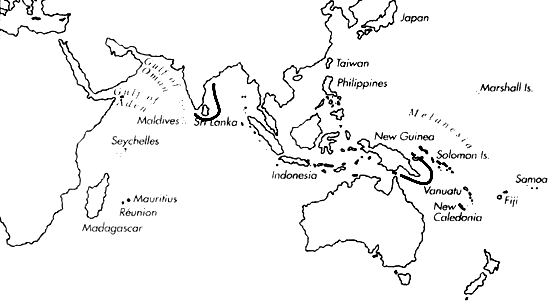
Skip Navigation Links
View access keys for this site.

Range: S. India and Sri Lanka. Probably also in Papua New Guinea.
Description: Usually medium-sized to moderately large, solid to heavy. Last whorl conical or ventricosely conical to broadly conical; outline variably convex at adapical third, straight below. Shoulder carinate. Spire of low to moderate height, outline concave to straight or sigmoid. Maximum diameter of larval shell 0.9-1 mm. First 3-5 postnuclear whorls tuberculate, later whorls carinate. Teleoconch sutural ramps flat to concave or sigmoid, with 1-2 increasing to 4-7 spiral grooves; on latest ramps, grooves weaker and with additional spiral striae. Last whorl with distinct or weak spiral ribs and ribbons at base.
| Shell Morphometry | ||
|---|---|---|
| L | 45-83 mm | |
| RW | 0.35-1.13 g/mm | |
| (L 45-85 mm) | ||
| RD | 0.65-0.74 | |
| PMD | 0.81-0.92 | |
| RSH | 0.10-0.17 | |
Ground colour white. Last whorl usually with 2 variably broad, continuous or interrupted brown spiral bands, leaving ground- colour zones below shoulder, at centre and at base. White bands usually interspersed with dark brown axial streaks and flames and occasionally with additional brown spiral lines. Dashed dark brown spiral lines extend from base to shoulder but vary in number and arrangement. Pattern very variable; largely white shells intergrade with shells overlaid with various shades of brown and shells with primarily spirally arranged pattern intergrade with shells with axial arrangement. Larval whorls pale orange. Later sutural ramps with very sparse to numerous brown markings; intensity of maculation not correlated with last whorl pattern. Aperture white.
Periostracum yellow, thin, translucent, smooth (Kohn, 1978a).
Habitat and Habits: In 5-55 m, mainly on sand (Kohn, 1978a).
Discussion: C. malacanus is similar to C. sukhadwalai and sometimes also to C. lenavati; for comparison see the DISCUSSIONS of those species. Subadult specimens of C. malacanus may be confused with C. eximius. However, shells of the latter species differ in its usually narrower last whorl (RD 0.60-0.68), often higher spire (RSH 0.08-0.26) and have neither tuberculate nor carinate spire whorls. The holotype of C. cuneatus is a subadult specimen of C. malacanus with reduced pattern.

C. malacanus range map
This section contains verbatim reproductions of the accounts of 316 species of Conus from the Indo-Pacific region, from Manual of the Living Conidae, by Röckel, Korn and Kohn (1995). They are reproduced with the kind permission of the present publisher, Conchbooks.
All plates and figures referred to in the text are also in Röckel, Korn & Kohn, 1995. Manual of the Living Conidae Vol. 1: Indo-Pacific Region.
The range maps have been modified so that each species account has it own map, rather than one map that showed the ranges of several species in the original work. This was necessary because each species account is on a separate page on the website and not confined to the order of accounts in the book.
Return to framed version (returns to search page)